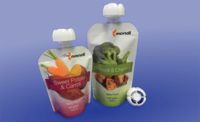Flexible Packaging Stays in Tune with Changing Consumer Behavior, Lifestyles

Rapidly changing lifestyles and demographics are altering U.S. consumer behavior, eating patterns, new product development and, inevitably, the design of consumer packaging. Consumer goods manufacturers can look to flexible packaging for help in adapting to the new market realities.
Chief among the trends is today’s faster pace and busier lifestyles, and their impact on consumer behavior. Fewer meals, for example, take place with friends and family at the kitchen table. According to the NDP Group, a leading market research firm, over 50 percent of meals in the U.S. are eaten alone, including 60 percent of breakfasts, 55 percent of lunches and 32 percent of dinners. Many meals are eaten in the car, while beverages are often consumed outdoors and on the go.
Contributing to the solo-dining trend is the rapid growth of smaller households. According to the U.S. Census Bureau, 27 percent of all households today consist of just one person, the highest level in U.S. history.
High-Convenience Options
Flexible packaging developers are responding to these trends with a variety of packaging options, such as single-serve containers and various integrated convenience features. The options include packaging that can be gripped with one hand and easily opened without utensils; spouts that dispense product at a steady rate and reduce the risk of spills; and bags with durable handles that resist spilling and allow easy pouring.
Variations in package sizing, meanwhile, are being used to differentiate brands. An example is so-called miniaturized packaging for fruit snacks, shampoo, personal-care products and the like. The mini packages can fit into a pocket, backpack or purse. This is a boon for people on the go, as well as city dwellers and others who shop frequently and prefer lighter packaging.
Catering to Busy Parents
Among the busier, more active groups are parents with young children. They can benefit from flexible spouted pouches as alternatives to glass baby food jars. The pouches, designed to be gripped by tiny hands, give children greater independence and allow them to feed themselves with parental supervision.
One recent innovation is food pouches with extra-large, choke-avoidance caps, which serve as a deterrent to swallowing. As a further measure, the caps have a unique shape that can allow air to pass through even if swallowed.
Appealing to Seniors
Another demographic trend affecting packaging is the growing senior population. About 8,000 baby boomers retire every day, a rate that will continue until 2029, reports the American Association of Retired Persons (AARP). Flexible packaging innovations that appeal to seniors include easy-open/close packaging. An example is flexible bags equipped with laser scoring or perforations that allow opening with minimal force. Also, spouted pouches are now made with large, easy-to-grip spouts, in diameters of 1¼ inches or more. They can be unscrewed with less effort than most glass jars.
Reclosable features favored by seniors include built-in sliders and zip locks. These closure designs can now be incorporated into such products as pet food, food, laundry detergent, cleaning supplies and lawn care items. They preserve the freshness and potency of packaged goods longer than previous generations of closures and help prevent spoilage, enabling seniors to derive full value from their purchases.
Sustainability Gains
Sustainability issues are also affecting packaging design and selection. Flexible packaging typically weighs less and is easier to ship than rigid plastic containers. Switching from rigid to flexible packaging can reduce inbound transportation cost and promote more efficient use of pallets and warehouse space. In addition, flexible packaging developers are working on ways to improve post-consumption recycling of flexible bags and pouches.
Keeping up with the Future
Flexible packaging has proved extremely resilient in adapting to changing consumer behavior and market conditions. Expect to see more innovative solutions in the years ahead as flexible packaging keeps pace with emerging social and consumer trends.
Looking for a reprint of this article?
From high-res PDFs to custom plaques, order your copy today!




